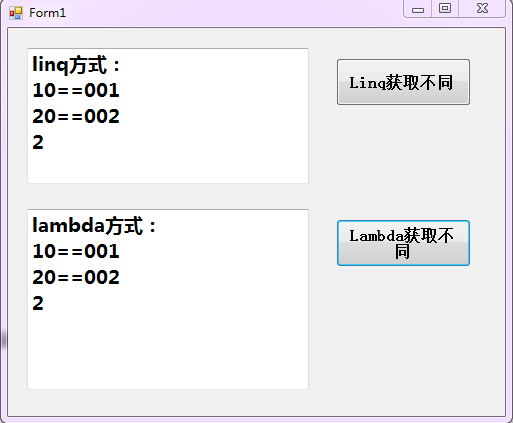方式一:Linq
List<Test> list = new List<Test>();
list.Add(new Test { score = 10, name = "张君宝" });
list.Add(new Test { score = 20, name = "刘惜君" });
list.Add(new Test { score = 20, name = "刘惜君" });
list.Add(new Test { score = 30, name = "八戒" });
int total = (from temp in list
where temp.name == "刘惜君"
select temp.age).Count();
int score = (from temp in list
where temp.name == "刘惜君"
select temp.score).Sum();
this.textBox1.Text = "刘惜君:" + total + "人" + score + "score";
C#中两个List<TModel>中根据指定条件获取不同对象 续
原始需求:已经插入的数据不再重复插入(所有数据中排除已有数据,不存在数据以新对象形式存储在对象三中)
using System;
using System.Collections.Generic;
using System.Linq;
using System.Windows.Forms;
namespace StartExe
{
public partial class Form1 : Form
{
private List<Test> AllData = new List<Test>();
private List<Test> PartData = new List<Test>();
public Form1()
{
InitializeComponent();
AllData.Add(new Test { score = 10, name = "001" });
AllData.Add(new Test { score = 20, name = "002" });
AllData.Add(new Test { score = 30, name = "003" });
AllData.Add(new Test { score = 40, name = "004" });
PartData.Add(new Test { score = 30, name = "003" });
PartData.Add(new Test { score = 40, name = "004" });
}
//方法:Linq
private void btnLinq_Click(object sender, EventArgs e)
{
LinqMethod(AllData, PartData);
}
private void LinqMethod(List<Test> allData, List<Test> partData)
{
var query = from a in allData.AsEnumerable()
join p in partData.AsEnumerable()
on a.score equals p.score into tmp
from current in tmp.DefaultIfEmpty()
where current == null
select new
{
Name = a.name,
SCORE = a.score,
};
string str = string.Empty;
foreach (var item in query)
{
str += item.SCORE + "==" + item.Name + "
";
}
this.txtLinq.Text = "linq方式:
" + str + query.Count().ToString();
//MessageBox.Show(str);
}
//方法:Lambda
private void btnLambda_Click(object sender, EventArgs e)
{
LambdaMethod(AllData, PartData);
}
private void LambdaMethod(List<Test> AllData, List<Test> PartData)
{
var query = AllData.AsEnumerable()
.GroupJoin
(
PartData.AsEnumerable(),
x => x.score, y => y.score, (x, y) => y.DefaultIfEmpty()
.Where(w => w == null).
Select(z => new { SCORE = x.score, Name = x.name })
).SelectMany(x => x);
string str = string.Empty;
foreach (var item in query)
{
str += item.SCORE + "==" + item.Name + "
";
}
this.txtLambda.Text = "lambda方式:
" + str + query.Count().ToString();
//MessageBox.Show(str);
}
}
public class Test
{
public int age { get; set; }
public string name { get; set; }
public int score { get; set; }
}
}
运行效果如下所示:
